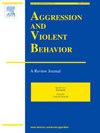Expanding contingency learning models of aggression in youth: Conceptual and methodological considerations to enhance clinical utility
IF 3.4
2区 心理学
Q1 CRIMINOLOGY & PENOLOGY
引用次数: 0
Abstract
Aggression in youth is a transdiagnostic indicator that permeates nearly all psychiatric disorders and is one of the most common reasons for mental health referrals. Contingency learning theories provide a framework for conceptualizing factors that elicit (antecedents) and maintain aggressive (consequences) behavior. For decades, theoretical and etiological models of aggression have emphasized individual differences in neurobiological reactivity during contingency learning as predictors of aggression in youth. However, our ability to predict precisely when aggression will occur and why aggression persists over time remains limited, ultimately hindering our capacity to tailor and personalize interventions to maximize effectiveness. The current review summarizes research examining individual differences in neurobiological reactivity during stimulus-response (antecedents) and response-outcome (consequences) contingencies as predictors of aggression in youth. It then offers concrete recommendations for expansions of this work with an eye toward optimizing the prediction of aggression via the identification of proximal individual- and dyad-level antecedents and consequences. These include conceptual considerations such as examining aggression as a transdiagnostic construct, considering alternative internal and external antecedents and consequences of aggression, and explicating aggression within the dyadic context. Additionally, recommendations for methodological advancements are presented, including enhancing ecological validity of study designs, incorporating ambulatory assessments, and utilizing advanced analytic approaches that allow us to empirically test and identify proximal antecedents and consequences of aggression. Finally, we discuss how these advancements have the potential to increase the precision of intervention efforts to reduce aggression by creating a framework for systematically mapping within-individual and within-dyad processes that elicit and maintain aggressive behavior over time.
扩大青少年攻击的偶然性学习模式:概念和方法上的考虑,以提高临床效用
青少年的攻击性是一种跨诊断指标,几乎渗透到所有精神疾病中,是心理健康转诊的最常见原因之一。权变学习理论为引发(前因)和维持攻击性(后果)行为的因素概念化提供了一个框架。几十年来,攻击的理论和病因学模型都强调,在偶然性学习过程中,神经生物学反应的个体差异是青少年攻击的预测因素。然而,我们准确预测攻击何时会发生以及为什么攻击会持续一段时间的能力仍然有限,最终阻碍了我们定制和个性化干预措施以最大化效果的能力。当前的综述总结了在刺激-反应(前因)和反应-结果(后果)偶发事件中作为青少年攻击预测因素的神经生物学反应性的个体差异。然后,它为扩展这项工作提供了具体的建议,着眼于通过识别近端个体和双体水平的前因和后果来优化攻击的预测。这些包括概念性的考虑,如将攻击作为一种跨诊断的结构来检查,考虑攻击的其他内部和外部前因和后果,以及在二元语境中解释攻击。此外,还提出了方法学进步的建议,包括提高研究设计的生态有效性,纳入动态评估,以及利用先进的分析方法,使我们能够通过经验测试和确定攻击的近前因和后果。最后,我们讨论了这些进步如何有可能通过创建一个框架来系统地映射个体内部和双组内部的过程,从而提高干预工作的准确性,从而减少攻击行为,这些过程会随着时间的推移引发和维持攻击行为。
本文章由计算机程序翻译,如有差异,请以英文原文为准。
求助全文
约1分钟内获得全文
求助全文
来源期刊

Aggression and Violent Behavior
Multiple-
CiteScore
7.50
自引率
4.30%
发文量
63
期刊介绍:
Aggression and Violent Behavior, A Review Journal is a multidisciplinary journal that publishes substantive and integrative reviews, as well as summary reports of innovative ongoing clinical research programs on a wide range of topics germane to the field of aggression and violent behavior. Papers encompass a large variety of issues, populations, and domains, including homicide (serial, spree, and mass murder: sexual homicide), sexual deviance and assault (rape, serial rape, child molestation, paraphilias), child and youth violence (firesetting, gang violence, juvenile sexual offending), family violence (child physical and sexual abuse, child neglect, incest, spouse and elder abuse), genetic predispositions, and the physiological basis of aggression.
 求助内容:
求助内容: 应助结果提醒方式:
应助结果提醒方式:


